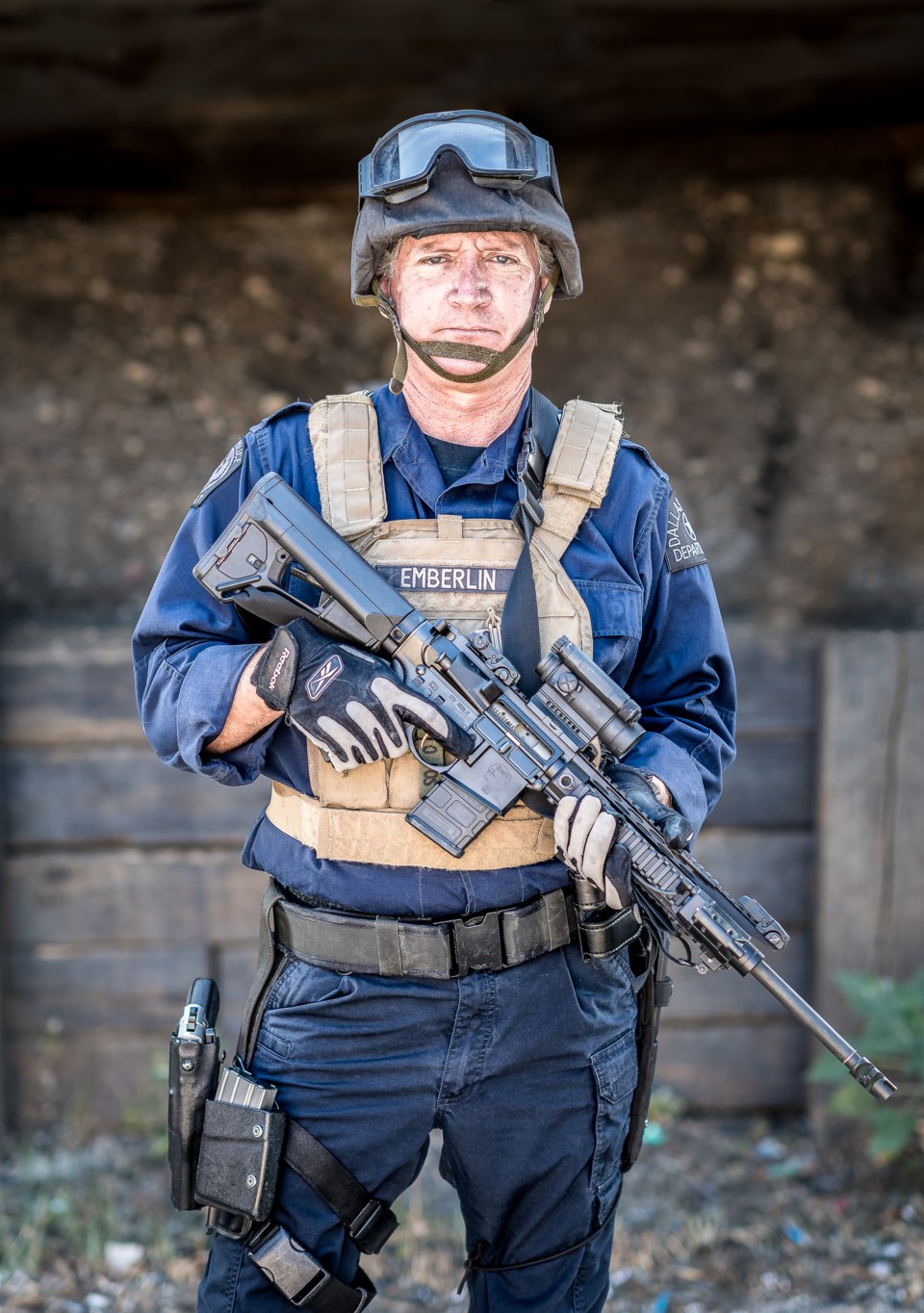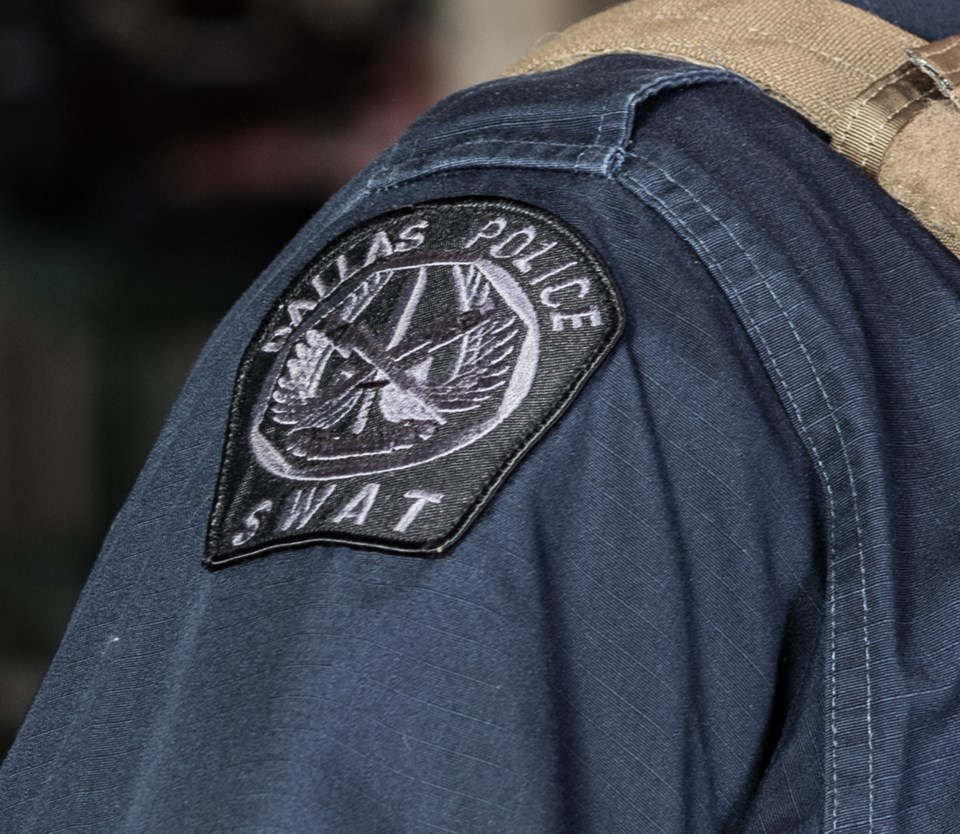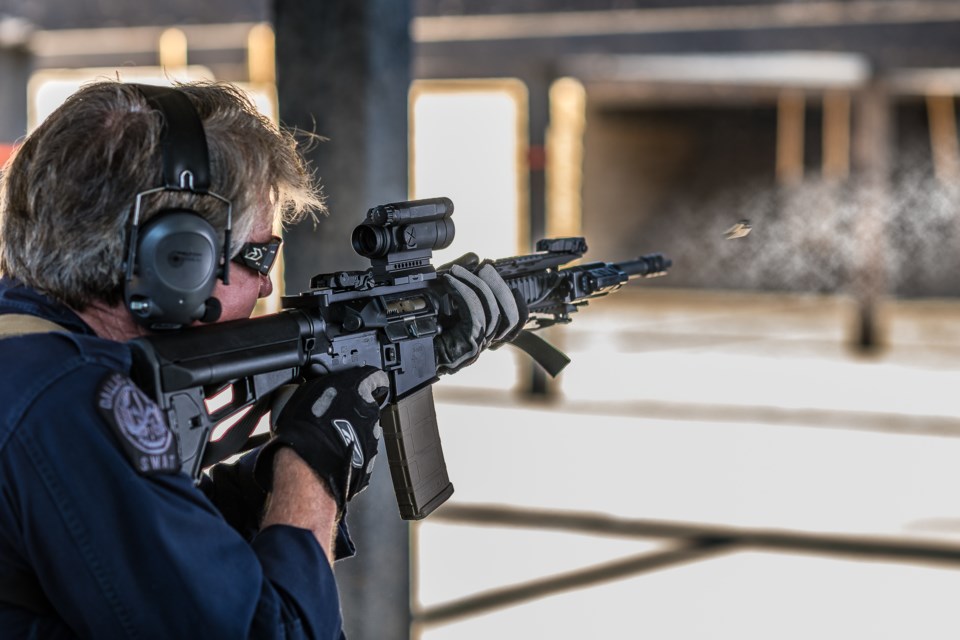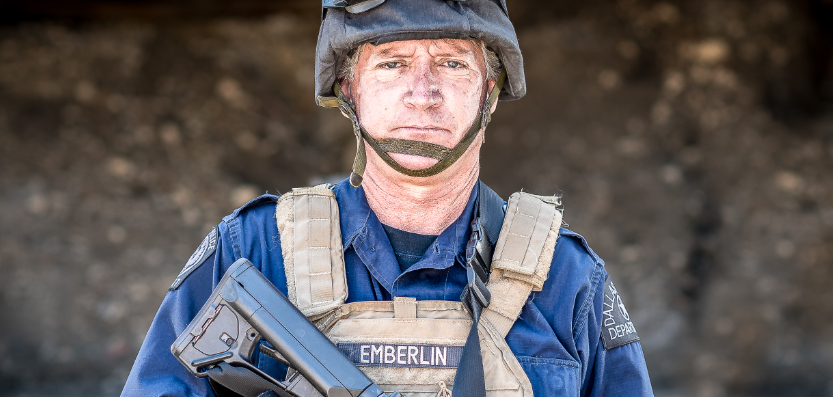From shootouts to hostage rescues, Rich Emberlin’s law enforcement career was nothing short of an adventure.

It was like an out-of-body experience; Rich Emberlin, a then-19-year veteran SWAT officer with the Dallas Police Department, was standing over the body of the first person he had shot and killed. The deceased man had just murdered his own toddler son after an hours-long standoff with the police. The suspect had told negotiators he was going to “finish it,” prompting Rich and his team to initiate a hostage rescue. When they made entry into the small apartment, the suspect started shooting at the officers. During the gunfire exchange, Rich could hear the sound of his own death being ejected in the form of bullets from the suspect’s pistol just feet away. He vividly remembers the sound of the bolt of his rifle cycling as he fired; at the same time, the horrifying pops of return fire echoed in his ears.
It all happened so fast. When the gunfire exchange was over, Rich wondered for a moment who had killed the man that was now lying on the ground at his feet; he then realized smoke was curling out of the barrel of his own rifle. When he became a law enforcement officer almost two decades earlier, he never wanted to actually shoot anyone.
Investigators were later surprised at Rich’s vivid memory of the event; typically, police officers experience physiological effects of shootings that include tunnel vision and auditory exclusion, but Rich remembered everything. He shot his rifle two times. The suspect shot back five.
“When someone is shooting at you, you take it personally,” Rich says. “I wasn’t panicked; I was just doing my job. But I was scared.”
Born in Waco, Texas, Rich grew up as a military brat with ambitions of joining the United States Air Force like his father did before him. As he moved around the world with his family, he was extremely shy and even more sheltered; the military bases where Rich and his family resided were so structured and close-knit that loyalty to the military took precedence over everything. He wasn’t even aware that other non-military jobs were available to him.
Rich went to college at the University of North Texas in Denton and received a degree in business administration. He planned to attend Officer Candidate School and go into the military upon graduation, but ran into a snag during their required physical assessment—Rich’s eyesight did not meet the present standards. In 1986, all pilots were required to have 20/20 uncorrected vision, and Rich’s was 20/25 due to a childhood injury; when he was 13, when his brother accidentally shot him in the right eye with a BB.
Rich was devastated. He’d spent his entire life planning to serve his country in the air force and without that dream, he was lost. Just out of college and struggling to figure out his next move, Rich worked as a buyer for Dillard’s. But being a buyer didn’t suit him; he craved action and adventure, and felt the constant desire to serve his community in a more meaningful way.
Read more: The horrifying reality of human trafficking in North Texas
After about a year at Dillard’s, Rich visited his cousin, a 30-year veteran of the Houston Police Department. They were on a standard ride-along when they heard a fellow officer screaming over the radio: “I’ve been shot!”
When they pulled up to the crime scene, Rich was told to stay in the car. Through the window he saw a plain-clothes cop leaning up against a building, grasping at his bloody thigh, still pointing his pistol at the suspect he’d just been forced to kill in order to save the hostage. Rich later learned that the injured officer had been involved in an undercover kidnapping payoff that went bad. Even though the operation failed, Rich couldn’t shake the feeling of admiration for the cop injured in the line of duty.
“I wanted to be that guy. He was was trying to serve and protect people,” Rich says. “Not that I needed to be a hero. But being a hero is a lot cooler than being a buyer.”

In the fall of 1987, Rich joined the Dallas Police Department. For years he worked as a patrolman in the Northwest Division of Dallas, which included both the projects and the fancy neighborhoods of Preston Hollow. During these years Rich was called to quell bar fights, stopped shootouts and stabbings, and responded to various disturbance calls.
“Being a patrolman is the most dangerous job in law enforcement,” he says. “Patrolmen are the backbone of the department.”
Rich was asked to join the Narcotics force five years later. He was given a new identity, grew his hair out and wore it in a ponytail that hung halfway down his back. He went by Richard Everman and had a prison inmate card that said he had once been locked up in Hunstville, Texas.
As part of his new Narcotics gig, Rich would often go into a bar and sit on a stool next to a guy he knew was dealing drugs. Rich would order a beer and casually offer to buy one for his neighbor. Opening his wallet, he would intentionally flash his inmate ID card, prompting the suspect to ask about Rich’s crimes.
“Burglary of a building,” Rich would say. “I just got out of prison.”
This was always followed by a laundry list of questions to verify that Rich was telling the truth: “Who was the warden? Who was your celly?”
Rich had to learn everything about everybody. If a suspect were to catch on to his deception, he could end up dead. During the three years that he worked in the unit, his caution and hyper-awareness of his surroundings increased significantly. The possibility of a drug deal gone bad was always in the forefront of his mind; he saw it happen to a couple of friends on the force. He was relieved to transition to the SWAT (Special Weapons and Tactics) team in 1996.
Rich worked in SWAT for 15 years, participating in counter-terrorist operations, responding to barricaded person reports, executing hazardous warrants, and hostage rescue situations. He was also one of the stars of A&E’s docu-series called Dallas SWAT, which followed elite Dallas SWAT team members through their daily lives—both work and personal—for the three seasons in 2006 and 2007.
In 2011, Rich was assigned to the Criminal Intelligence Unit’s Dignitary Protection Squad, which allowed him to interact with many people that he could only dream of meeting—presidents and other politicians, religious figures like the Dalai Lama, and sports team owners and powerful business professionals. It was a change of pace from his last two assignments; working in the Dignitary Protection Squad wasn’t nearly as dangerous, but remained a highly challenging duty.
“When protecting important people, you aren’t only worried about violence,” Rich says. “You also have to worry about glitter bombs, pies in the face or someone calling them the c-word in a public forum.”
As of 2017, Rich is retired from the Dallas Police Department, but he remains active in the field. He is a tactical instructor for a defense contractor and started a company called 540 Solutions, which offers coverage for anyone visiting the DFW area that needs protection. He also teaches training classes for police and military personnel. Recently, Rich made his second reality television debut on Bravo’s hit series The Real Housewives of Dallas as the fiancé of housewife LeeAnne Locken.

During his career, Rich was stabbed in the hand and shot at on multiple occasions. He has metal plates in his face and several rods in his back. But what affects him the most are the terrible crimes he has seen—the heinous acts of other human beings that are scarred into his mind forever—and the times when his line of work made him feel sad.
“It’s hard being ‘that guy,’ especially among your peers,” Rich says. “The guy who shot someone out of self-defense, or the guy who wasn’t able to save a kid, or prevent a deadly accident … it’s lonely being that guy, and sometimes as a cop, that’s where you end up.”
But despite all of the danger and harsh realities that being a cop imposed, Rich loved every minute of his law enforcement career. He has always felt that it was his duty to serve his community, and insists that most of the people he interacted with were not criminals. They were people in crisis.
“We are just human beings watching people do inhumane things,” Rich says.
Rich recalls a specific rescue mission where a man was holding his wife and two kids hostage in their home in the Dallas projects. Though they were still waiting on authorization to enter, Rich and a fellow SWAT team member snuck into the house when they heard the desperation in the voices of those trapped inside. The suspect had thrown the family’s furniture down the stairwell, leaving a jungle gym for Rich to climb over as he ascended to the second story. When he reached the top of the stairs, he saw the woman hostage collapse in relief—he will remember the thankful look on her face forever.




